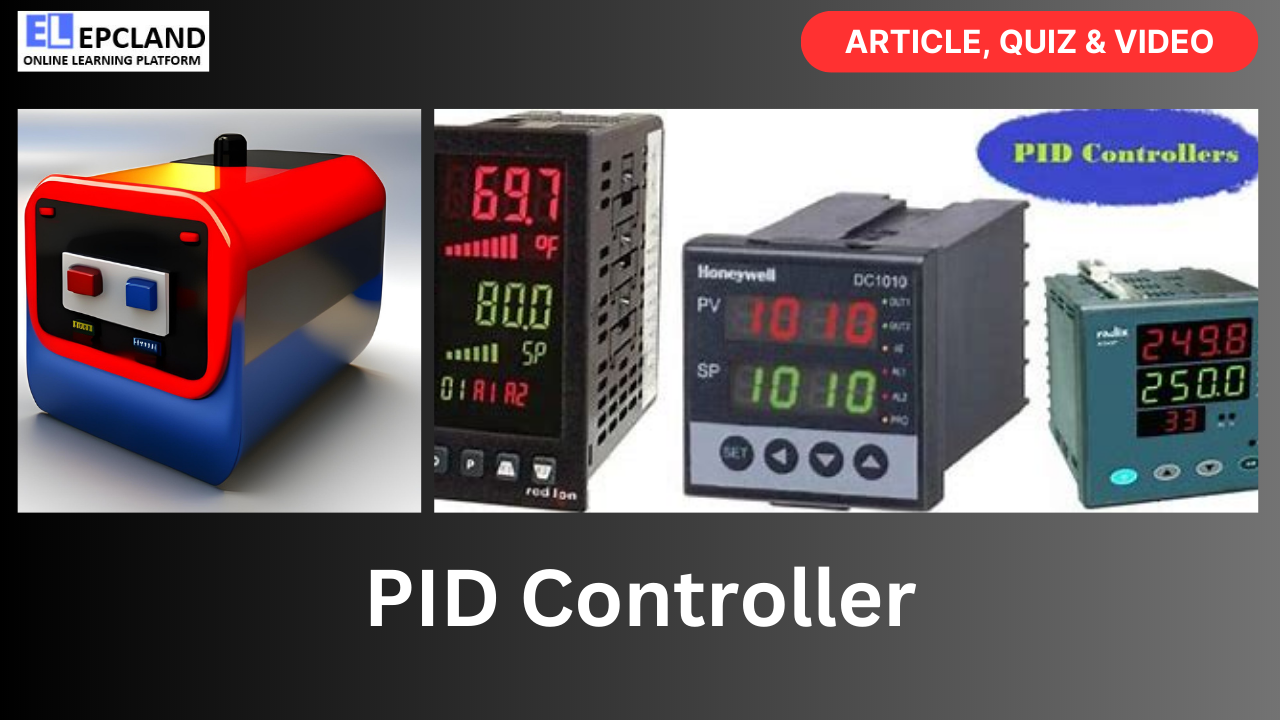The Oil and Gas Industry is a sprawling, multifaceted sector that relies on precise control of various processes, from drilling and refining to distribution and safety systems. One of the pivotal components in achieving this control and optimizing operations is the PID (Proportional-Integral-Derivative) controller. In this article, we’ll explore how PID controllers are employed in Oil and Gas Industry projects, their essential principles, real-world applications, and the significant impact they have on efficiency, safety, and overall productivity.
Table of Contents
Do not miss the Complete Course on Piping Engineering
By EPCLand
Understanding PID Controllers
Before delving into their applications in the Oil and Gas Industry, let’s grasp the fundamentals of PID controllers.
Proportional Control (P)
Proportional control is the simplest component of the PID controller. It calculates an error value as the difference between the desired setpoint and the measured process variable. The controller then applies a proportional gain (Kp) to this error to produce a control output.
Integral Control (I)
Integral control focuses on eliminating the long-term steady-state error. It continuously sums the error values over time and multiplies this cumulative error by the integral gain (Ki) to generate the control output. This action ensures that any persistent deviation from the setpoint is gradually corrected.
Derivative Control (D)
Derivative control anticipates future errors by evaluating the rate of change of the error. It multiplies the rate of error change by the derivative gain (Kd) to influence the control output. This action helps prevent overshooting the setpoint and stabilizes the system.
Working Principle
The working principle of a PID controller involves three actions:
- Proportional Action (P): The proportional term produces an output value that is proportional to the current error value. The proportional response can be adjusted by multiplying the error by a constant known as Kp.
- Integral Action (I): The integral term is concerned with the accumulation of past errors. It adds up all the past error values over time and multiplies this total error by a constant Ki. This term is used to eliminate any remaining steady-state error and brings the process variable to the setpoint.
- Derivative Action (D): The derivative term is a prediction of future error, based on its rate of change. It is calculated by determining how fast the error is changing with respect to time. The derivative response can be adjusted by multiplying the rate of change of error by a constant Kd.
The combination of these three actions produces a control output that can quickly respond to changes in the process variable (P), eliminate long-term deviations (I), and dampen oscillations (D).
The Role of PID Controllers in Oil and Gas Industry Projects
Precision and Stability
The Oil and Gas Industry relies heavily on precise control to maintain stable and efficient processes. PID controllers are indispensable in achieving this by continuously adjusting control inputs based on real-time measurements. Whether it’s maintaining the pressure in a pipeline or the temperature in a distillation column, PID controllers ensure that processes operate within desired parameters.
Real-time Monitoring and Control
Oil and gas facilities often consist of numerous interconnected processes and equipment. PID controllers are deployed across these systems to ensure they work in harmony. These controllers can monitor and adjust variables like pressure, flow rates, and temperatures, optimizing the overall performance of the facility.
Safety and Emergency Shutdown Systems
Safety is paramount in the Oil and Gas Industry due to the potential hazards associated with hydrocarbons. PID controllers play a crucial role in safety systems, such as emergency shutdown (ESD) systems. In the event of a hazardous condition, these controllers can rapidly close valves, halt operations, and initiate safety protocols to prevent accidents.
Energy Efficiency
Efficiency is a key concern in an industry where energy costs are a significant factor. PID controllers help maximize energy efficiency by fine-tuning processes to minimize wastage and reduce operating costs. For example, in a natural gas processing plant, PID controllers can optimize the combustion process to maximize energy extraction.
Quality Control
Quality control is essential in the Oil and Gas Industry, especially in refining and petrochemical processes. PID controllers ensure that the composition of final products meets stringent specifications by precisely controlling variables such as temperature and pressure.
Real-world Applications of PID Controllers
To appreciate the versatility of PID controllers in the Oil and Gas Industry, let’s explore some practical applications:
1. Pressure Control in Pipelines
Maintaining the pressure within pipelines is critical for the safe and efficient transportation of hydrocarbons. PID controllers are employed to regulate the operation of pumps and valves, ensuring that the pressure remains within the specified range. This helps prevent leaks, ruptures, and other safety hazards.
2. Temperature Control in Refineries
Refineries process crude oil into various products, such as gasoline and diesel. Precise temperature control is essential in these processes to achieve the desired chemical reactions and product quality. PID controllers adjust heating and cooling systems to maintain temperatures within tight tolerances.
3. Flow Control in Gas Distribution
In gas distribution networks, PID controllers are used to regulate the flow of natural gas to consumers. These controllers ensure that the pressure remains constant and that gas is delivered at the required rate, even when demand fluctuates.
4. Furnace Control in Petrochemical Plants
Petrochemical plants use high-temperature furnaces for various processes. PID controllers manage the combustion process in these furnaces to maintain consistent temperatures and optimize fuel efficiency.
5. Safety Shutdown Systems
PID controllers are a critical component of safety shutdown systems in oil and gas facilities. When a hazardous condition is detected, such as a gas leak or excessive pressure, PID controllers trigger immediate shutdowns to prevent accidents and protect personnel and assets.
Do not miss the Complete Course on Piping Engineering
By EPCLand
Advantages and Disadvantages of PID Controllers
Here’s a table summarizing the advantages and disadvantages of using PID controllers in the Oil and Gas Industry:
| Advantages | Disadvantages |
|---|---|
| Precise control of processes, leading to increased efficiency and product quality | Complex tuning process to optimize controller performance |
| Versatile and adaptable to various processes and industries | May struggle to control highly non-linear systems without advanced tuning |
| Integral action eliminates steady-state error, ensuring the process variable reaches the setpoint | Reliability is critical; controller failures can have severe consequences |
| Derivative action helps prevent overshooting and stabilizes the system | Vulnerable to cyberattacks in interconnected control systems |
| Essential for safety systems, such as emergency shutdown (ESD) | Requires ongoing monitoring and maintenance for optimal performance |
| Improves energy efficiency and reduces operating costs | |
| Supports real-time monitoring and control of interconnected processes | |
| Enhances product quality through precise control of variables |
Challenges and Considerations in PID Controller Implementation
While PID controllers offer significant benefits, their implementation in the Oil and Gas Industry does present challenges:
1. Tuning Complexity
PID controllers require proper tuning to perform optimally. Achieving the right balance between proportional, integral, and derivative gains can be a complex and time-consuming process.
2. Non-linearity
Oil and gas processes can be highly non-linear, meaning that the relationship between input and output is not always straightforward. PID controllers may struggle to maintain stability in such systems without advanced tuning and adaptive control strategies.
3. Reliability
In critical applications, PID controllers must be highly reliable. Failures in the controller can have severe consequences, so redundancy and fail-safe mechanisms are often necessary.
4. Cybersecurity
As industrial control systems become more connected, PID controllers are vulnerable to cyberattacks. Ensuring the cybersecurity of these controllers is essential to protect critical infrastructure.
Future Trends and Innovations
The Oil and Gas Industry is continually evolving, and PID controllers are no exception. Here are some future trends and innovations:
1. Advanced Control Algorithms
Advances in control theory are leading to more sophisticated algorithms that can handle complex and non-linear processes. These algorithms may reduce the need for manual tuning and improve controller performance.
2. Integration with AI and Machine Learning
AI and machine learning are being integrated into control systems, allowing controllers to learn from data and adapt to changing conditions more effectively. This can lead to better control and increased energy efficiency.
3. Remote Monitoring and Control
The industry is exploring remote monitoring and control capabilities, allowing operators to manage processes from anywhere in the world. This trend can improve operational flexibility and reduce the need for on-site personnel.
Conclusion
PID controllers are the unsung heroes of the Oil and Gas Industry, quietly working behind the scenes to ensure that processes run smoothly, efficiently, and safely. From maintaining pressure in pipelines to controlling temperatures in refineries, these controllers play a pivotal role in achieving precise control and optimizing operations.
As the industry continues to evolve and face new challenges, PID controllers will remain a critical tool for achieving control, efficiency, and safety. Their adaptability and versatility make them an indispensable asset in an industry where precision and reliability are paramount. With ongoing advancements in control theory and technology, PID controllers will continue to play a vital role in shaping the future of the Oil and Gas Industry.
Do not miss the Complete Course on Piping Engineering
By EPCLand
FAQs
- What is a PID controller, and how does it work in the Oil and Gas Industry?A PID controller is a feedback control system used in the Oil and Gas Industry to regulate various process variables such as pressure, temperature, and flow. It operates based on three main components: Proportional (P), Integral (I), and Derivative (D) actions. These components work together to continuously adjust control inputs based on real-time measurements, ensuring processes operate within desired parameters.
- What are the advantages of using PID controllers in the Oil and Gas Industry?PID controllers offer several advantages, including precise control of processes, improved energy efficiency, enhanced safety through emergency shutdown systems, and the ability to maintain stable and efficient operations. They are versatile and adaptable to various industry processes, making them a valuable tool for optimizing operations.
- What are the key challenges in implementing PID controllers in the industry?Implementing PID controllers can be challenging due to the complexity of tuning to optimize controller performance, especially in highly non-linear systems. Reliability is a critical concern, as controller failures can have severe consequences. Additionally, with increasing connectivity, ensuring the cybersecurity of PID controllers is essential to protect critical infrastructure.
- How are PID controllers evolving in response to industry demands?PID controllers are evolving through advanced control algorithms, integration with artificial intelligence (AI) and machine learning, and the adoption of remote monitoring and control capabilities. These advancements are aimed at improving control, reducing manual tuning efforts, enhancing energy efficiency, and offering operational flexibility.
- What are some real-world applications of PID controllers in the Oil and Gas Industry?PID controllers find applications in various critical areas, such as pressure control in pipelines to prevent leaks, temperature control in refineries for product quality, flow control in gas distribution networks to maintain constant pressure, furnace control in petrochemical plants for optimal fuel efficiency, and as a part of safety shutdown systems to prevent accidents during hazardous conditions. Their versatility makes them indispensable in these applications.
Recommended courses (Published on EPCLand)
- Basics of Piping Engineering
- Piping Layout Engineering
- Piping Material Engineering
- Piping Stress Analysis
- Complete Course on Piping Engineering
- Material Requisitions
- Piping Material Specifications
- Valve Material Specifications
Don’t miss the published articles on following:
| Data Analysis and Technology with Link | Data Analysis and Technology with Link |
| Data Analytics | Industrial Control Networks |
| Machine Learning | The Power of Acoustic Sensors |
Related Video
Attempt Quiz
Question 1:
What does “PID” stand for in the context of control systems used in oil & gas projects?
Explanation: In the context of control systems used in oil & gas projects, “PID” stands for Proportional-Integral-Derivative, which is a type of control algorithm.
Question 2:
What is the primary purpose of a Proportional component in a PID controller?
Explanation: The primary purpose of the Proportional component in a PID controller is to reduce steady-state error by adjusting the control output in proportion to the error signal.
Question 3:
Which component of a PID controller is responsible for eliminating long-term errors?
Explanation: The Integral component of a PID controller is responsible for eliminating long-term errors by continuously summing the error signal over time and adjusting the control output accordingly.
Question 4:
What is the role of the Derivative component in a PID controller?
Explanation: The role of the Derivative component in a PID controller is to reduce sudden changes in the control output by providing a control action based on the rate of change of the error signal.
Question 5:
In oil & gas applications, where might you commonly find PID controllers used?
Explanation: In oil & gas applications, PID controllers are commonly used for industrial control of temperature, pressure, and flow in processes such as refining, pipeline control, and petrochemical manufacturing.



